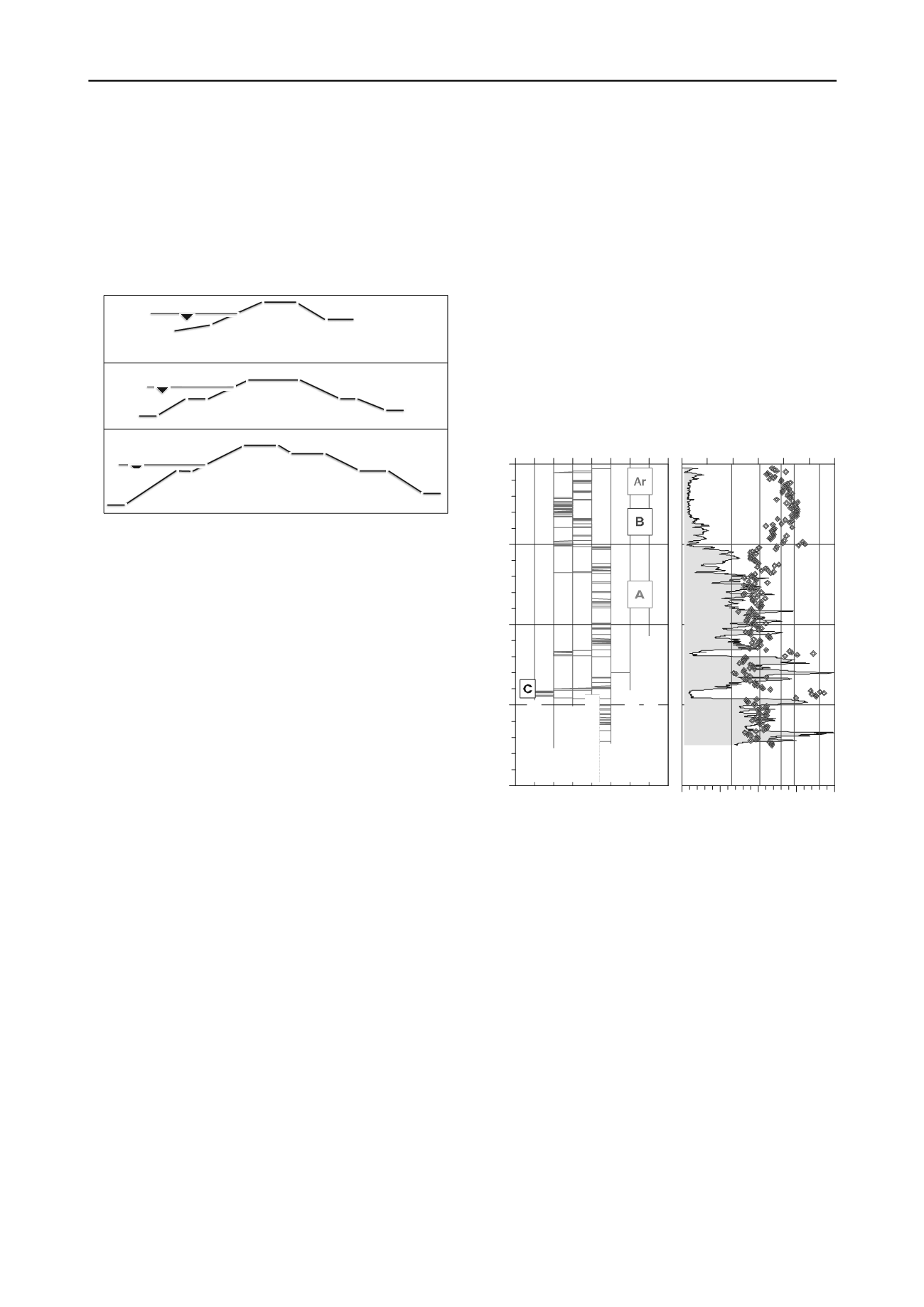
1485
Technical Committee 203 /
Comité technique 203
� �
�
�i���������������
��i���������
� � � � �
����i�����������
� �i���������
� � � � � � �
����i�����������
��i�����������
� � �
P��Riv���
P��Riv���
P��Riv���
- the geometry of the embankment (Figure 4): in particular, the
height (variable from 2 to 23 m) - upstream and downstream -
and the number of berms;
- the kind of foundation soil, upstream and downstream;
- the seismic input from local site response;
- the presence of a diaphragm wall at the embankment toe,
downstream;
- the reported historical failures.
A total of 43 significant sections was finally selected for the
stability analyses.
Figure 4. Typical geometries of the Po riverbanks.
4 GEOTECHNICAL CHARACTERIZATION
ical
different, predominantly
-
minantly silty sediments (
SBT
zone 4), with
-
ayey sediments (
SBT
zone 3), with
y,
de
Stratigraphic soil profiling as well as geotechn
characterization of the riverbank sediments and the surrounding
subsoil mainly relied on in situ tests, with special reference to
piezocone data. In addition, laboratory test results were used as
supporting reference data in order to validate the CPTU-based
correlations adopted in estimating the relevant soil parameters.
In this procedure, detailed stratigraphic profiles were derived by
applying the well-known and newly revised classification
framework developed by Robertson (2009), based on the stress
normalized CPTU measurements. As an example, Figure 5
provides a typical output of the method, consisting in a profile
of the different Soil Behaviour Type (SBT) classes detected
along the vertical in conjunction with the CPTU-based material
index
I
cn
values. The analysis of such profiles allows identifying
a number of homogeneous soil layers, which generally turn out
to agree fairly well with the available geological classification.
According to the analyses carried out so far, the following
typical soil units were identified:
- Unit A
r
, a complex alternation of
coarse grained sediments such as sands, silty sands, silts to
clayey silts, forming the riverbanks;
Unit A, sand;
- Unit B, predo
sandy and clayey lenses.
Unit C, predominantly cl
occasional presence of peat and organic soils (
SBT
zone 2).
Geotechnical properties describing soil state, stress histor
formation and strength characteristics were derived from
piezocone tests using empirical correlations. Attention was
particularly focused on the estimate of the effective stress
strength parameters to be used in the stability analyses, hence
various transformation models were considered in order to
relate test measurements to the most appropriate soil property
value. As regards friction angle in sands, empirical relationships
relying on relative density were considered, together with the
well-known normalized cone resistance-based correlations
proposed by Robertson & Campanella (1983) and later by
Kulhawy & Mayne (1990). In fine-grained soils, the effective
stress friction angle was determined from the normalized CPT
readings
Q
t
= (q
t
- σ
v0
)/σ'
v0
and
Bq =Δu/(q
t
- σ
v0
)
(Senneset
et al.
1989). It is worth observing that, in order to develop a
probabilistic stability analysis of riverbanks, the adopted soil
characterization procedure includes a rather straightforward
method for the assessment of inherent soil variability.
According to such approach, the geotechnical property
variability is concisely described by the coefficient of variation
(Phoon & Kulhawy, 1999). Thus, the geotechnical
characterization of each soil unit needs the definition of the
mean value of the soil property together with the associated
standard deviation
SD
and coefficient of variation
CoV
. From
the interpretation of the large amount of available data, it turns
out that unit A is typically characterized by a mean friction
angle φ′
m
= 35°÷36° and a standard deviation SD
2°; unit B
by φ′
m
32°and SD
1°, unit C by φ′
m
24° and SD
2°.
Finally, as regards the sandy-silty mixtures forming the
riverbanks, typical values of mean friction angle φ′
m
are 32°
with a standard deviation SD
1.5°.
1 2 3 4 5 6 7 8 9
Soil Behaviour Type Zone
(Robertson, 2009)
40
30
20
10
0
Depth (m)
q
t
Sands
Sand Mixtures
Silt Mixtures
Clays
Organic Soils
Gravelly Sands
Very Stiff/Clayey Sands
0 5 10 15 20 25 30
Corrected Cone Resistance
q
t
(MPa)
0 1 2 3
SBT Index,
I
cn
4
SBT zone
7 6 5 4 3 2
I
cn
Figure 5. Results from CPTU-based classification
5 LABORATORY TESTING
of the CPTU-based empirical
ratory testing for lithologic
Unit A
r
*.
In order to verify the reliability
relationships adopted in the study and the intrinsic variability of
the geotechnical properties, estimated for each lithological unit,
laboratory tests were performed on undisturbed samples taken
at different depths and from boreholes even very distant to each
other. Seventy undisturbed samples were analyzed, 19 from
lithologic Unit Ar*, 17 from Unit B, 16 from Unit C, 2 from
Unit D2 and 16 from Unit A. Laboratory testing program
included identification and classification tests, oedometric tests,
different types of shear strength tests (Direct Shear Test, DST,
and triaxial tests, TxCIU, TxCID), resonant column (RC) and
torsional cyclic tests. The experimental results from the
representative samples of lithologic Units Ar* are shown in
Table 1. In particular, for each property, the number of tested
specimens, mean, minimum and maximum values, standard
deviation and coefficient of variation are reported. Kind of
testing, number of specimens, values of the parameters and
correlation coefficients are provided for drained and undrained
shear strength and for normalized shear modulus and damping
ratio versus shear strain relationships.
Table 1. Geotechnical properties from labo


